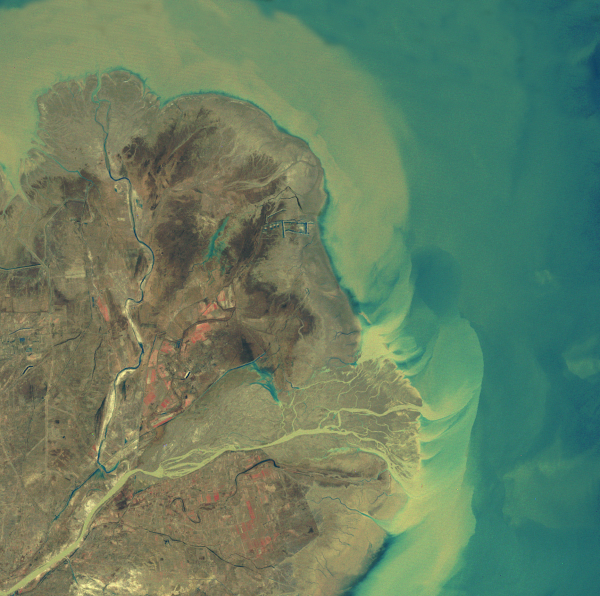Research
Optimized deltaic diversion scenarios
Project overview
Hundreds of millions of people live on river deltas around the world, representing a rich diversity in culture and generating thriving economies. Governments have sought ever more drastic measures to prevent flooding and protect society and its infrastructure on deltas. But, these policies can harm the natural environment and lead to loss of precious land.
Unified under a framework published in PNAS (Moodie & Nittrouer, 2021), research in this theme examines factors impacting diversion effectiveness. For example, projects examine evolution of distributary networks formed from diversion efflux, as well as the optimal location and design for diversions. Topics integrate modeling, sediment composition analyses, ecology, and human dimensions.
This research has been supported by an NSF Graduate Research Fellowship from 2016–2019 and an international NSF Coastal SEES grant.

Introduction
By restricting river channels on deltas, we have limited the delivery of sediment to the coast where it is needed to sustain land in the face of rising sea level. This is problematic, because delta lands lessen flooding by diminishing storm surge intensity. The irony here is that by preventing the river from flooding naturally, we have exacerbated land loss, and in the long run, have made society more susceptible to catastrophic floods, including from rivers and ocean storms.
Recently, diversions have been engineered on deltas globally, with the intention of building land (for example, Figure 1). However, diversions are often placed very near the coast, because it costs less and minimizes the impact on major population centers. But, these downstream locations may be ineffective at maintaining the natural delta land building function.
Methods

It is illustrative to think about diversion planning relative to the choice to do nothing. For example (Moodie & Nittrouer, 2021) give the dimensionless framework for societal net benefit for natural landscape management (i.e., natural avulsion; $\lambda_{\Pi,\textrm{natural}}$) and for a managed delta (i.e., artificial diversion; $\lambda_{\Pi,\textrm{diversion}}$). Together, these benefit formulations give the sustainability number $\mathcal{S}$:
\[\mathcal{S} = \frac{\lambda_{\Pi,\textrm{diversion}}}{\lambda_{\Pi,\textrm{natural}}},\]where a value greater than unity indicates a delta management strategy providing a net benefit to society. In that study, we explored how the sustainability number depends on various parameters and informs delta sustainability.
We are also interested in using sedimentology and geomorphology to inform optimal diversion design. For example, we have examined the impact shallow discrete faulting-induced subsidence has on diversion effectiveness (missing reference), whereby we show that distributary network reorganization downstream of diversion sites due to faulting-induced subsidence may delay land building. The magnitude of delayed land building is quantified by a dimensionless ratio relating fault displacement length scales to distributary network characteristics, so that results are generalized to real-world deltaic systems. Detailed understanding of sediment transport mechanics is necessary to predict sediment transported through diversions during low- and flood-stage conditions (Moodie et al., 2020).
Insights
Many studies have said that society, in particular major cities like New Orleans, are doomed, and that engineering efforts leveraging nature-based solutions can’t coexist with large population centers. We’ve shown that having cities nearby actually makes it even easier to justify large projects. With better design (e.g., diversions need to be placed farther upstream than existing structures), delta sustainability may be enabled by diversions.
Publications generated by this research
- Moodie, A. J., Nittrouer, J. A., Ma, H., Carlson, B. N., Wang, Y., & Lamb, M. P. (2021). Suspended-sediment induced stratification inferred from concentration and velocity profile measurements in the flooding lower Yellow River, China. Water Resources Research. doi: 10.1029/2020WR027192
- Moodie, A. J., & Nittrouer, J. A. (2021). Optimized river diversion scenarios promote sustainability of urbanized deltas. Proceedings of the National Academy of Sciences, 118(27). doi: 10.1073/pnas.2101649118
- Moodie, A. J., & Passalacqua, P. (2021). When does faulting-induced subsidence drive distributary network reorganization? Geophysical Research Letters, 48(22). doi: 10.1029/2021GL095053
- Passalacqua, P., & Moodie, A. J. (2022). System-scale solutions for human-scale needs. Science, 376-6596. doi: 10.1126/science.abq1166
References
Moodie, A. J., & Nittrouer, J. A. (2021). Optimized river diversion scenarios promote sustainability of urbanized deltas. Proceedings of the National Academy of Sciences, 118(27). doi: 10.1073/pnas.2101649118
Moodie, A. J., Nittrouer, J. A., Ma, H., Carlson, B. N., Wang, Y., & Lamb, M. P. (2020). Suspended-sediment induced stratification inferred from concentration and velocity profile measurements in the flooding lower Yellow River, China. Water Resources Research. doi: 10.1029/2020WR027192
